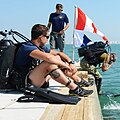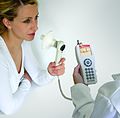Diving safety
Diving safety is the set of practices, procedures, and measures used to reduce the risks associated with underwater diving, and to enhance the safety of divers and support personnel. It includes the provision of diving services, the management of diving operations, and the use of diving equipment.
Overview[edit]
Underwater diving is a potentially hazardous activity, and it is essential for divers to be adequately trained, to be fit for the diving activity, and to use appropriate equipment that is in good working order. The risk of diving can be reduced by following safe diving practices and procedures, and by maintaining a high level of physical fitness.
Diving Safety Measures[edit]
Diving safety measures include the use of diving equipment such as diving suits, diving masks, diving regulators, and diving cylinders. These equipment are designed to protect the diver from the underwater environment and to provide the diver with the necessary breathing gas.
The use of dive computers and dive tables is also an important part of diving safety. These tools provide the diver with information about the depth and duration of the dive, and the decompression stops that may be required during the ascent.
Diving Safety Procedures[edit]
Diving safety procedures include the use of buddy diving system, where two divers dive together and look out for each other's safety. It also includes the use of dive plans, which outline the planned depth and duration of the dive, the decompression stops, and the emergency procedures.
Diving Safety Management[edit]
Diving safety management involves the provision of diving services, the management of diving operations, and the use of diving equipment. It includes the training and certification of divers, the inspection and maintenance of diving equipment, and the planning and supervision of diving operations.
See Also[edit]
References[edit]
<references />
Ad. Transform your life with W8MD's Budget GLP-1 injections from $75


W8MD offers a medical weight loss program to lose weight in Philadelphia. Our physician-supervised medical weight loss provides:
- Weight loss injections in NYC (generic and brand names):
- Zepbound / Mounjaro, Wegovy / Ozempic, Saxenda
- Most insurances accepted or discounted self-pay rates. We will obtain insurance prior authorizations if needed.
- Generic GLP1 weight loss injections from $75 for the starting dose.
- Also offer prescription weight loss medications including Phentermine, Qsymia, Diethylpropion, Contrave etc.
NYC weight loss doctor appointmentsNYC weight loss doctor appointments
Start your NYC weight loss journey today at our NYC medical weight loss and Philadelphia medical weight loss clinics.
- Call 718-946-5500 to lose weight in NYC or for medical weight loss in Philadelphia 215-676-2334.
- Tags:NYC medical weight loss, Philadelphia lose weight Zepbound NYC, Budget GLP1 weight loss injections, Wegovy Philadelphia, Wegovy NYC, Philadelphia medical weight loss, Brookly weight loss and Wegovy NYC
|
WikiMD's Wellness Encyclopedia |
| Let Food Be Thy Medicine Medicine Thy Food - Hippocrates |
Medical Disclaimer: WikiMD is not a substitute for professional medical advice. The information on WikiMD is provided as an information resource only, may be incorrect, outdated or misleading, and is not to be used or relied on for any diagnostic or treatment purposes. Please consult your health care provider before making any healthcare decisions or for guidance about a specific medical condition. WikiMD expressly disclaims responsibility, and shall have no liability, for any damages, loss, injury, or liability whatsoever suffered as a result of your reliance on the information contained in this site. By visiting this site you agree to the foregoing terms and conditions, which may from time to time be changed or supplemented by WikiMD. If you do not agree to the foregoing terms and conditions, you should not enter or use this site. See full disclaimer.
Credits:Most images are courtesy of Wikimedia commons, and templates, categories Wikipedia, licensed under CC BY SA or similar.
Translate this page: - East Asian
中文,
日本,
한국어,
South Asian
हिन्दी,
தமிழ்,
తెలుగు,
Urdu,
ಕನ್ನಡ,
Southeast Asian
Indonesian,
Vietnamese,
Thai,
မြန်မာဘာသာ,
বাংলা
European
español,
Deutsch,
français,
Greek,
português do Brasil,
polski,
română,
русский,
Nederlands,
norsk,
svenska,
suomi,
Italian
Middle Eastern & African
عربى,
Turkish,
Persian,
Hebrew,
Afrikaans,
isiZulu,
Kiswahili,
Other
Bulgarian,
Hungarian,
Czech,
Swedish,
മലയാളം,
मराठी,
ਪੰਜਾਬੀ,
ગુજરાતી,
Portuguese,
Ukrainian














